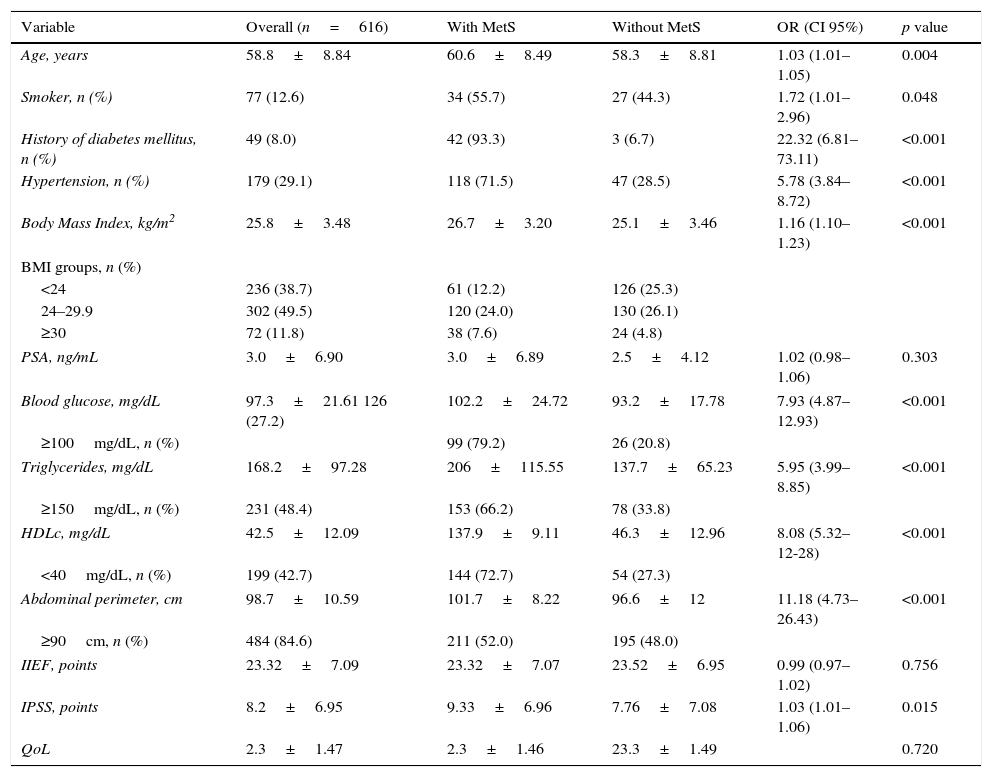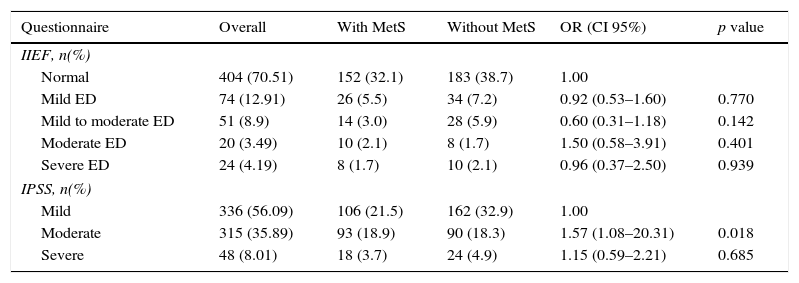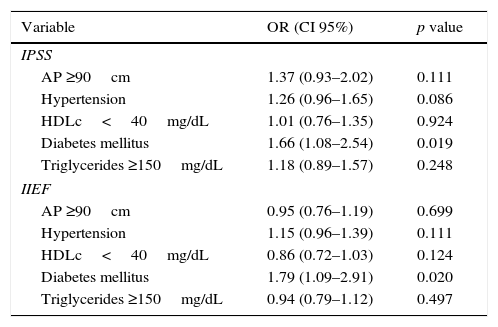To estimate the frequency of metabolic syndrome (MetS) in a daily urology practice and to determine its association with lower urinary tract symptoms (LUTS) and erectile dysfunction (ED).
Material and methodsA retrospective study was conducted. Data from all male patients aged ≥40 years who attended our outpatient urology clinic from 2010 to 2011 was collected. Prevalence of MetS was determined, and LUTS and ED were assessed. A logistic model was used to determine possible associations, controlling for confounders and interaction factors.
ResultsA total of 616 patients were included. MetS was observed in 43.8% (95% CI 39.6–48.3). The bivariate model showed an association between MetS and LUTS (p<0.01), but not between MetS and ED. The logistic model showed an association between MetS and the International Prostate Symptom Score (IPSS), while controlling for other variables. Patients exhibiting moderate LUTS had a greater risk for MetS than patients with mild LUTS (OR 1.83, 95% CI 1.14–2.94). After analyzing for individual components of MetS, positive associations were found between diabetes and severe LUTS (OR 1.3, 95% CI 1.24–7.1), and between diabetes and ED (OR 2.57, 95% CI 1.12–5.8).
ConclusionThis study was able to confirm an association between MetS and LUTS, but not for ED. Specific components such as diabetes were associated to both. Geographical differences previously reported in the literature might account for these findings. Given that MetS is frequent among urological patients, it is advisable that urologists actively screen for it.
Estimar la frecuencia de síndrome metabólico (SMet) en la consulta urológica ambulatoria y su asociación con los síntomas del tracto urinario inferior y la disfunción eréctil.
Material y métodosEstudio retrospectivo que incluyó a todos los hombres de ≥40 años que consultaron ambulatoriamente entre 2010 y 2011. Se calculó la prevalencia de SMet, síntomas del tracto urinario inferior y disfunción eréctil. Se utilizó un modelo logístico para comprobar posibles asociaciones, controlando por interacciones y factores de confusión.
ResultadosSe incluyeron 616 pacientes. Se encontró SMet en el 43,8% (IC 95%: 39,6-48,3) de los pacientes. El análisis bivariado demostró una asociación entre SMet y síntomas del tracto urinario inferior (p<0,01), pero no con disfunción eréctil. El modelo logístico demostró una asociación independiente entre SMet y la severidad de los síntomas urinarios por puntuación en el IPSS, siendo mayor el riesgo de SMet en aquellos con síntomas moderados que con síntomas leves (OR: 1,83; IC 95%: 1,14-2,94). Se analizaron por separado los diferentes componentes del SMet y se encontraron asociaciones positivas entre diabetes, síntomas severos (OR: 1,3; IC 95%: 1,24-7,1) y disfunción eréctil (OR: 2,57, IC 95%: 1,12-5,8).
ConclusiónSe confirmó la asociación entre SMet y síntomas del tracto urinario inferior, pero no para disfunción eréctil. La diabetes, un componente específico del SMet sí se asoció con ambas condiciones. Las diferencias geográficas previamente reportadas en la literatura podrían explicar estos resultados. Debido a que el SMet es frecuente entre los pacientes urológicos, un tamizado activo por parte de los urólogos es recomendable.










